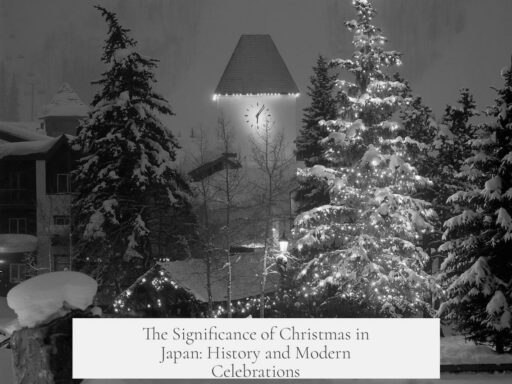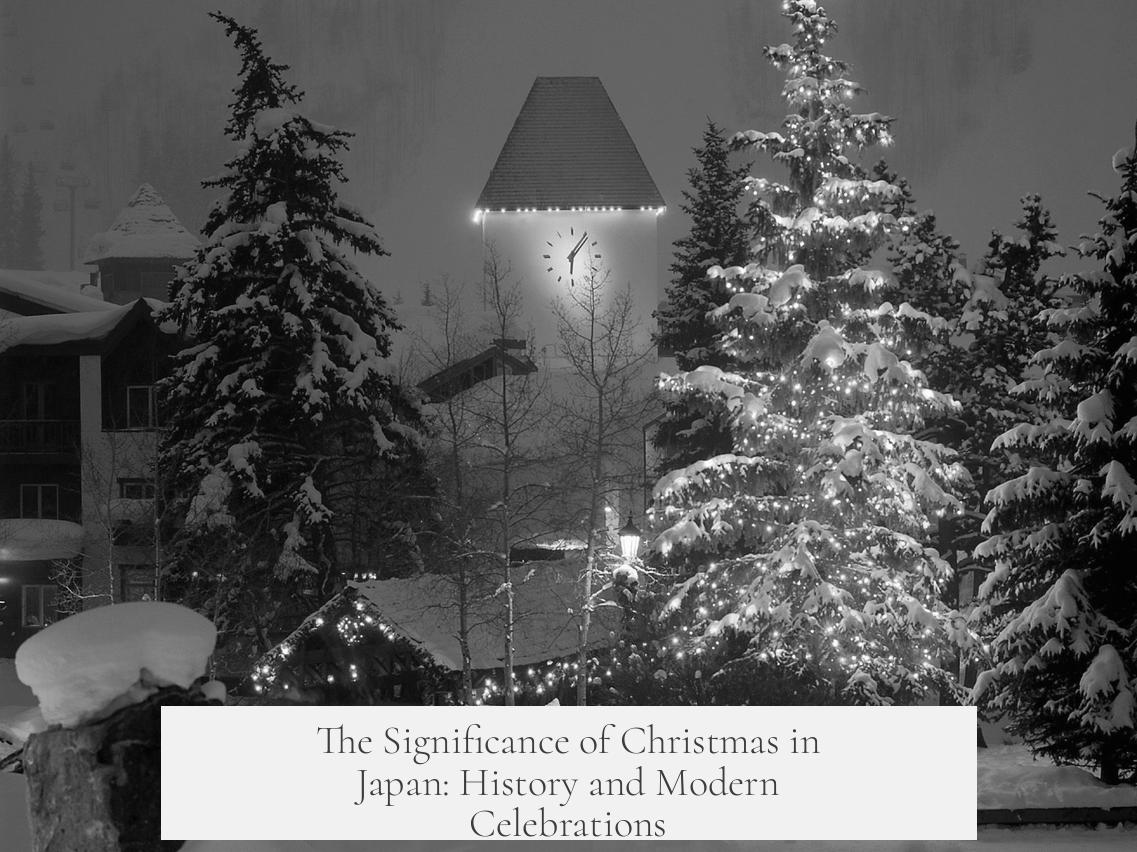Christmas is a major event in Japan despite Christians making up less than 1% of the population because it has evolved into a secular, commercial, and social celebration rather than a religious one. This transformation began in the post-World War II period when American and European cultural influences introduced Christmas customs as part of a wider global exchange. The holiday quickly shifted away from its Christian roots in Japan, becoming a festive occasion aligned more with romance and consumerism than with religious observance.
Christmas in Japan closely resembles Valentine’s Day in how it is celebrated. The focus is often placed on couples rather than families or religious worship. This romantic aspect emerged notably after the war, influenced by social changes such as increased freedoms for women and evolving ideas about love and relationships. Japanese media during the Occupation era reflected new concepts of romance, helping fuel a cultural shift.
During the 1980s and 1990s, Christmas advertising increasingly targeted young couples rather than families. This change corresponded with demographic trends, including a declining birthrate and a growing number of single women with financial independence. Commercial entities responded by tailoring Christmas products to appeal to women, recognizing their strong consumer power. For example, variations in Christmas cakes catering to diverse tastes illustrate this strategic marketing.
| Aspect | Explanation |
|---|---|
| Origins | Imported post-war from America and Europe, merging various global practices into a secular celebration |
| Romantic Focus | Shift from family to couples; fueled by post-war media and women’s changing social roles |
| Commercialization | Marketing targets young couples and women consumers; consumption patterns shift with economy |
| Non-traditional Customs | Ex: Japanese Christmas cakes differ from Western originals, emphasizing adapted cultural meaning |
The commercialization of Christmas in Japan has been dynamic and responsive to economic conditions. Businesses do not insist on “correct” ways to celebrate or consume Christmas products. Instead, they promote an open-ended model where consumers create their own meanings and traditions around the holiday. This flexibility helps Christmas maintain popularity despite the absence of religious significance.
Non-religious Christmas customs also illustrate how the holiday has become localized. For example, the Christmas cakes commonly enjoyed in Japan are distinct from European or North American versions. Additionally, the holiday’s portrayal in movies, television, and music reinforces its role as a festive and romantic occasion rather than a solemn religious event.
In summary, Christmas in Japan thrives as a secular celebration deeply influenced by post-war Western culture and adapted to domestic social changes. Romance, consumerism, and flexible customs define its appeal today.
- Christmas was introduced post-WWII mostly from American influences, becoming a secular holiday.
- It focuses on romance and couples, similar to Valentine’s Day, not religious significance.
- Advertising shifted to target young couples and empowered women as major consumers.
- The holiday is commercial and open-ended, allowing varied consumption and traditions.
- Japanese Christmas traditions, like special cakes, differ from Western norms, showing cultural adaptation.
Why is Christmas Such a Big Thing in Japan, a Country Where Christians Constitute Barely 1% of the Population? The Fascinating History of Christmas Celebrations in Japan

Christmas in Japan thrives not as a religious observance but as a unique social and commercial celebration shaped by post-war influences, romantic ideals, and evolving cultural attitudes. If you’re wondering how Christmas became such a huge milestone in a country where Christianity barely registers on the population radar, buckle up. Japan’s Christmas story is anything but typical.
Let’s embark on a cultural sleigh ride through history, economics, media, and social change to understand this festive anomaly. How did Christmas morph from a foreign ritual into one of Japan’s most anticipated events?
The Imported Origins: American and European Influences
Japan’s entry into the Christmas club wasn’t via a traditional religious path. Instead, the holiday shows up post-World War II with a very clear guest list of influences: mainly the Americans, sprinkled with a dash of Europeans.
As Japan recovered from the war, American customs, including Christmas festivities, made a robust cultural landing. Yet, rather than adopting Christmas wholesale as a Christian religious day, Japan embraced it as a secular and social occasion. This meant no nativity scenes or church services dominating the scene. Instead, it was an open invitation for fun, lights, and parties—an evergreen season for everyone, regardless of religious background.
This hybrid of global customs created a distinct Japanese take on Christmas. It borrows from the West but wears its own cultural outfit—secular and social, festive yet inclusive.
Christmas as a Romantic Holiday: Japan’s Own Twist
Here’s where things take an unexpected turn. In many Western countries, Christmas focuses on family, religious reflection, and gift exchanges among loved ones of all ages. Not so in Japan.
Christmas in Japan acts more like a Valentine’s Day for couples. Think romantic dinners, walking hand-in-hand under twinkling lights, and exchanging thoughtful presents with that special someone. It’s a holiday centered on romance, not religion or even family necessarily.
Why romantic? The roots trace back to post-war Japan during the American occupation era, when women started hosting Christmas parties as social gatherings. This coincided with a media wave promoting new, modern ideas of love, romance, and relationships. Women’s roles in society were shifting rapidly—gaining more freedoms and shaping public conversations about love like never before.
By the 1980s and 1990s, Christmas advertising caught the romance fever, focusing on young couples instead of families. This wasn’t just about sales tactics; it mirrored profound demographic trends including a falling birthrate and a rising number of single women with purchasing power. The holiday’s commercial and social scripts adapted accordingly.
Marketing Magic: Open-Ended Consumption and Consumer Culture
In Japan, Christmas isn’t tied to “correct” ways of celebration. The products and festivities don’t have to mimic Western traditions strictly. This flexible approach to Christmas consumption is a marketer’s dream.
For instance, Christmas cakes in Japan aren’t your typical fruitcake or gingerbread from Europe or America. They tend to be lighter, often strawberries atop spongy cakes, emphasizing aesthetics as much as taste. These cakes symbolize Christmas but don’t have a fixed “traditional” method of consumption. Marketers encourage consumers to create their own celebration style—no rules required.
Economically, Christmas blossomed in tandem with Japan’s post-war consumer boom. It became a commercial import, shifting focus depending on economic climate. When the 1990s brought economic stagnation, businesses tapped into single women’s increasing spending power, customizing products and advertisements that resonated with this demographic. So yes, Christmas in Japan is also a mirror reflecting its economy and societal changes.
Media, Pop Culture, and Shaping Festivities

The post-war media—movies, TV dramas, and magazines—played a massive role in crystallizing Christmas as a romantic, glamorous occasion. Social gatherings depicted in media fueled aspirations for cozy, festive evenings illuminated by Christmas lights. This portrayal planted Christmas deep into the consciousness as an event brimming with warmth and romance for the emerging modern Japanese urban lifestyle.
This potent cocktail of media influence, evolving social norms, and economic realities made Christmas far more than an imported foreign holiday. It evolved into a Japanese original, flexible and adapting to societal shifts.
Practical Tips: Experiencing Christmas in Japan
- Dates and Celebrations: Christmas Eve takes center stage as a romantic night for couples, not Christmas Day itself. Restaurants fill up with lovebirds enjoying festive meals.
- Christmas Cakes: Try the signature Japanese Christmas cake, a fluffy sponge adorned with fresh strawberries and whipped cream. It’s a sweet symbol of the season.
- Lights and Decorations: Stroll through dazzling illuminations in urban centers like Tokyo’s Shibuya or Osaka, where light displays rival any global metropolis.
- Gifts: It’s not about families exchanging gifts en masse but couples presenting thoughtful exchanges.
Summary: Why Such a Big Holiday Despite Low Christianity?
In essence, Christmas in Japan thrives because it fills a social and commercial niche rather than a religious one. It serves as a romantic milestone akin to Valentine’s Day, shaped by American influences, evolving gender roles, and strong economic drivers. The holiday’s flexibility and media reinforcement cement its popularity.
Japan didn’t copy Christmas verbatim. Instead, it reimagined the event for its unique cultural context. This identity shows how global traditions morph in fascinating ways when they meet different histories and societies.
Final Thoughts
Have you ever thought about how holidays travel and change? Japan’s Christmas reminds us that even something as seemingly straightforward as a holiday can carry layers of history, commerce, gender dynamics, and pop culture. Next time you see a Christmas cake in Japan, remember it’s more than dessert—it’s a symbol of cultural remixing at its finest.
So, the next time you’re in Japan around December, don’t look for the Christmas nativity scene. Instead, look for the couples dining under the glow of neon lights, the festive cakes, and the streets lit like a dream. It’s Christmas, Japanese-style—romantic, commercial, and utterly captivating.




